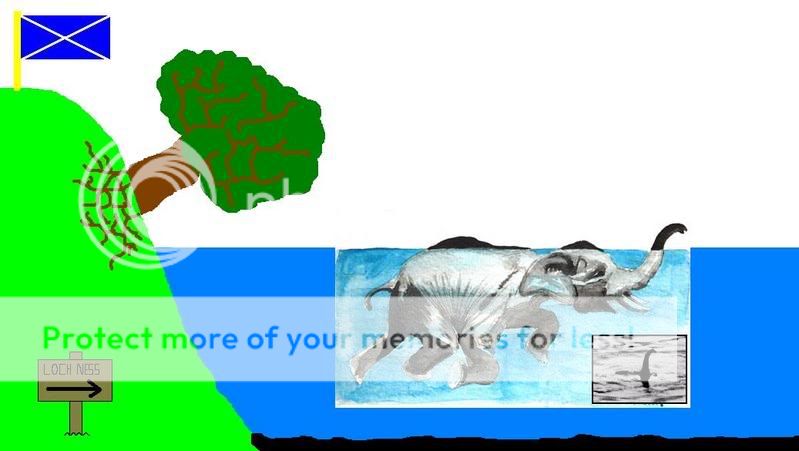Right folks, here come the references, nicely digested by:
Steuart Campbell, The Loch Ness Monster. The Evidence, Aberdeen University Press, 1986, rev ed. 1991.
In Chapter 1 (pp. 13-22), the author gives the background and discusses what can count as evidence. He points out that there are no large underwater tunnels or underwater caves in the loch; it's one of those smooth glaciated valleys that you find in northern Europe. Also any tunnel connecting it with the sea would drain it, as the loch is 16 metres above sea level. So whatever lives in the loch, according to Campbell, would have to stay there. As the lake has been probed with sonar and radar (chapter 4), any such caves or tunnels would have been found- as would the monster.
He also lists sources of possible deception in eyewitness accounts, such as water movement, swimming deer and otters, mirages, floating logs. Evidence from the Baker & Westwood expedition of 1962 (Campbell, p. 22) would seem to suggest that wave/wake phenomenons are probably the most common source of deception.
In chapter 2 (pp. 23-34) he goes through a series of eyewitness reports and discusses them in terms of possible sources of deception- particularly standing waves, otters and deer. There is a particularly interesting one of what was probably an otter: when first interviewed, the witness estimated its length at 2 metres, 3 years later it had "grown" to 9 metres (p. 32). Also, an interesting sketch of an eyewitness' impression of the monster juxtaposed to an artist's impression of a 2-year-old swimming deer.
In chapter 3 (pp. 35-50), Campbell goes through the 21 extant still photos (discussion summed up on pp. 112) and the evidence, including photographic angles, distances etc. It turns out you cannot rely on what people say about the conditions under which they took their photos.
It's pretty obvious that 7 of the pictures are hoaxes, 5 definitely of natural phenomena. Another few, discussed, in chapter 5, are pretty underwater pictures of, respectively, mud on the bottom of the loch, and a tree stump. The remaining are very unclear, but Campbell thinks it likely that they are also of natural phenomena.
And there are the movies- Chapter 4 (pp. 53-64, with summing-up on pp. 112-3)! Several of these are inaccessible, alleged to be locked in a bank vault- which means they can't be used as evidence. One, at least, is probable a hoax, one shows waterbirds, one is now, according to C, known to be of a dead horse. In fact, there does not seem to be any that cannot be explained in terms of natural phenomena or fakes.
Chapter 5 (pp. 65-74) is the underwater photography. The slight problem here is that the Rhines expedition who set up an underwater camera in the 1970s overestimated the depth of that strecth of lake which meant that the camera that should have been floating free in the water photographing anything that came swimming by was in fact rolling around on the loch bed, taking pictures of the mud and old rubbish there.
Finally, the sonar and radar- Chapter 6 (pp. 75-97). The first sonar was from a fishing boat- a little suspicious in itself as commercial fishing is not allowed in the Loch Ness, so why was the sonar on? Apparently, the skipper has later admitted it was a hoax. Other reports appear to have been of schools of fish.
Expeditions were arranged by Oxford and Cambridge in 1960, by Cambridge in 1962 and by Birmingham university in 1968, using sonar, but nothing conclusive was found. It was the 1962 expedition that swept the lake from end with a fleet of sonar-equipped boats and found nothing. The Academy of Applied Science did expeditions in 1970, 1972 and 1976, but it seems likely that the signals they picked up were of their own boats...; there were certainly serious methodological problems with the interpretation of the evidence. Another expedition in 1981-5 by the Loch Ness and Morar Project also got no evidence.
(For those who have never seen sonar in action, I may add that it can be extremely hard to interpret; things don't look anything like in real life)
There has been one radar report- unconfirmed, as far as I can make out.
To add my personal reflections to this, I would [point out to the posters who have postulated something, even if it's only an unknown species of fish, that there are several known species that would do just as well for creating these effects. If a shoal of unknown fish, why not a shoal of salmon? Instead of some weird salamander, why not the bog standard otter? If wake from a swimming monster, why not wake from a steamer (it is known that such wake can surface after the boat has passed out of sight)? The 1962 expedition found that wake from boats was a major source of deception for their crew.
As for those who believe in a plesiosaurus, they would need to explain how it got there (no evidence in sediment cores taken that the loch has ever been connected to the sea) and how it can manage to subsist in such cold temperatures.
Anyway, that's my scientific contribution for today.
Oh, and anyone who wants references to Campbell's sources, do let me know. It's not all lurking in mysterious bank vaults.


 That's the kind of response I like to see. Thank you for clarifying your point.
That's the kind of response I like to see. Thank you for clarifying your point. 


 "Nessie the elephant flapped her trunk and scared the hell out the scottish............"
"Nessie the elephant flapped her trunk and scared the hell out the scottish............" 